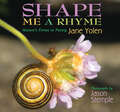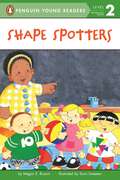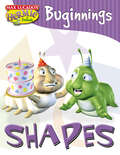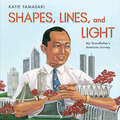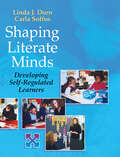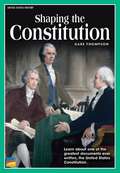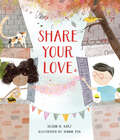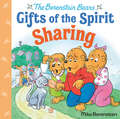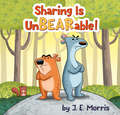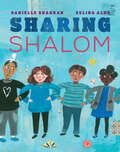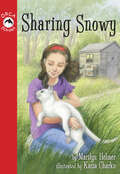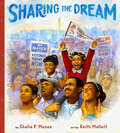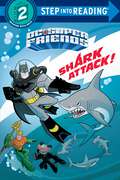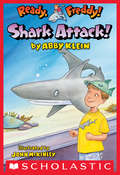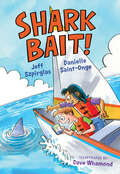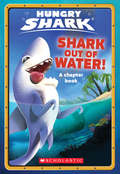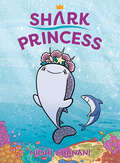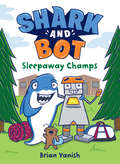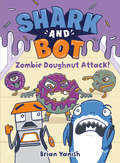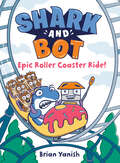- Table View
- List View
Shape Me a Rhyme: Nature's Forms in Poetry
by Jane YolenIn this unusual collection, poems and photographs focus on shapes in nature. Some shapes are found in familiar places: A circle is the sun and a crescent is the moon. But there are imaginative surprises too: an alligator's tooth is a triangle and a frond's shadow forms a square. Related shape words—round, halo, sphere, etc.—are scattered throughout the spreads. This collaboration captures the beauty of shapes in nature in a playful way.
Shape Spotters (Penguin Young Readers, Level 2)
by Megan E. BryantMs. Carey's class is looking for shapes in their school. Rectangles, triangles, circles, and squares are just a few of the shapes that they find. Hidden in the art of this Level 2 reader, children will find and identify all sorts of shapes!
Shapes (Max Lucado's Hermie & Friends)
by Max LucadoHermie has invited WormieTM over to play his new board game, "Get into Shapes." With a flick of the spinner, Hermie and Wormie are literally bending over backwards to do their best caterpillar impressions of the shape that the arrow lands on. The tumbling, bumbling caterpillars attract the attention of the other garden inhabitants, and soon, the whole group of insects is 'getting into shapes.' Antonio AntTM lends his sectional body to create a perfect triangle; Lucy LadybugTM's wing forms an exact semicircle, and Schneider the SnailTM has to expend little effort to exhibit a circle. Children will laugh and learn as the caterpillar crew teaches them to identify circles, squares, triangles, and other shapes-with an underlying message of using individual strengths toward a team effort.
Shapes, Lines, and Light: My Grandfather's American Journey
by Katie YamasakiKatie Yamasaki’s newest picture book celebrates the life of her grandfather, the acclaimed Japanese American architect Minoru Yamasaki. Minoru Yamasaki described the feeling he sought to create in his buildings as “serenity, surprise, and delight.” Here, Katie Yamasaki charts his life and work: his childhood in Seattle’s Japanese immigrant community, paying his way through college working in Alaska’s notorious salmon canneries, his success in architectural school, and the transformative structures he imagined and built. A Japanese American man who faced brutal anti-Asian racism in post–World War II America and an outsider to the architectural establishment, he nonetheless left his mark on the world, from the American Midwest to New York City, Asia, and the Middle East. This striking picture book renders one artist’s work through the eyes of another, and tells a story of a man whose vision, hard work, and humanity led him to the pinnacle of his field.
Shaping Earth's Surface: Ice
by Nash KramerIn this book you will learn how ice shapes Earth's surface.
Shaping Literate Minds: Developing Self-Regulated Learners
by Linda Dorn Carla SoffosHow can teachers create a literacy curriculum that builds processing links between reading, writing, and spelling knowledge? In Shaping Literate Minds: Developing Self Regulated Learners , Linda J. Dorn and Carla Soffos illustrate how processing theory can be applied to the everyday practices of classroom teaching. If instruction emphasizes the interrelationships of these three language areas, students learn how to transfer knowledge, skills, and strategies across literacy events. This is complex theory, but the authors provide clear and practical examples to support teachers as they incorporate these ideas into their classroom practices. Grounded in authentic experiences from primary classrooms, this book provides: Explanations of processing behaviors among reading, writing, and spelling knowledgeObservational tools that support teachers in noticing changes over time in specific literacy behaviorsGuidance on creating conditions for developing self-regulated learnersAuthentic reading and writing samples and teacher/student interactionsFigures and pictures that clearly describe how teachers can use assessment to inform and guide instruction, with links to national standardsDetails for establishing a school-based literacy model that includes team meetings, assessment walls, high standards, and a curriculum for literacyAppendixes with reproducible assessment checklists, report cards, task cards for literacy corners, and guided reading observation forms for team meetingsWith a national emphasis on accountability, high standards, and literacy achievement, Shaping Literate Minds will help teachers and administrators implement a high-quality literacy curriculum that links to national and state goals.
Shaping the Constitution
by Gare ThompsonFind out about the ideas in the United States Constitution and the men who helped create it.
Share Your Love
by Susan B. KatzA playful, rhyming book for kids ages 3-7 on how to send loving, kind thoughts to yourself and others to make the world a better place. Keep sharing your love from morning till night. See the change you can make with a love that shines bright. Worried or sad, grateful or glad, you can send good wishes to yourself, others, and the whole world with your thoughts! Just repeat these simple phrases: &“May you be protected and safe. May you feel happy and pleased. May your body be healthy, and may you live with ease.&” This book teaches young readers that even from far away, you can wish others happiness, good health, peace, and safety. Starting with the individual child and extending outward to the whole universe, the rhyming couplets and beautiful art carry the reader through the thoughtful process of extending love and kindness to yourself and all those around you. The book makes a great daily ritual to increase lovingkindness, and if a child is having a rough time or witnessing outside struggles, they can use the repeated phrases in the book to find peace and calm.
Share Your Rainbow: 18 Artists Draw Their Hope for the Future
by VariousWhen the storm subsides and the sun comes out, don't forget to look for the rainbow!Inspired by kids across the country displaying rainbows in their windows, acclaimed illustrators come together to imagine everything these rainbows represent: caring for one another, and our hopes for the future. In this collection of eighteen scenes, readers will lick an ice cream cone, swim in the ocean, cuddle close with cousins, and celebrate a birthday with a party full of friends and family. Each spread has a hidden rainbow for kids to find!An introduction by R. J. Palacio, New York Times bestselling author of Wonder, reminds us that rainbows have always been symbols of hope, and that as fleeting as a rainbow may seem, we can always look for the next one--in the sky, on the sidewalk, and in a window.100% of net proceeds from the sale of this book will go to World Central Kitchen, using the power of food to help our communities weather this storm.
Shared Reading Coaching Tool: 3 Days, 1 Book, 3 Times Through
by Marsha SpearsThis handy resource can be used by teachers, classroom volunteers, and parents for large-or small-group shared reading instruction. Scripted language, fun activities, and sample questions on topics such as directionality, text conventions, high-frequency words, and comprehension provide the instructor with reading strategies to support beginning and advanced readers.
Sharice's Big Voice: A Native Kid Becomes a Congresswoman
by Sharice Davids Nancy K. Mays TBDThis acclaimed picture book autobiography tells the triumphant story of Sharice Davids, one of the first Native American women elected to Congress, and the first LGBTQ congressperson to represent Kansas.When Sharice Davids was young, she never thought she’d be in Congress. And she never thought she’d be one of the first Native American women in Congress. During her campaign, she heard from a lot of doubters. They said she couldn’t win because of how she looked, who she loved, and where she came from.But everyone’s path looks different and everyone’s path has obstacles. And this is the remarkable story of Sharice Davids’ path to Congress.Beautifully illustrated by Joshua Mangeshig Pawis-Steckley, an Ojibwe Woodland artist, this powerful autobiographical picture book teaches readers to use their big voice and that everyone deserves to be seen—and heard!The back matter includes information about the Ho-Chunk written by former Ho-Chunk President Jon Greendeer, an artist note, and an inspiring letter to children from Sharice Davids."Rich, vivid illustrations by Ojibwe Woodland artist Pawis-Steckley are delivered in a graphic style that honors Indigenous people. The bold artwork adds impact to the compelling text." (Kirkus starred review)"The prose is reminiscent of an inspirational speech (“Everyone’s path looks different”), with a message of service that includes fun biographical facts, such as her love of Bruce Lee. Pawis-Steckley (who is Ojibwe Woodland) contributes boldly lined and colored digital illustrations, inflected with Native symbols and bold colors. A hopeful and accessible picture book profile." (Publishers Weekly)"Affecting picture-book autobiography." (The Horn Book)Acclaim includes:A Bank Street Best Children's Book of the Year 2022 - Outstanding Merit in biography and memoirOn Here Wee Read's 2021 Ultimate List of Diverse Children's Books2022 ALSC Notable Children’s Books in the middle readers category2022 Booklist from Rise: A Feminist Book Project—Early Readers NonfictionNominee for 2022 Reading the West book awardSelected as CCBC Choices 2022—biography, autobiography and memoir
Sharing (Berenstain Bears Gifts of the Spirit)
by Mike BerenstainBrother doesn't want to share his ice pop with Sister and Honey in this new Berenstain Bears Gifts of the Spirit faith-based hardcover storybook!This 32-page hardcover Berenstain Bears Gifts of the Spirit storybook, created by Mike Berenstain, son of Stan and Jan Berenstain, includes a soon-to-be classic story about the joy of sharing with family and friends! Children ages 3 to 7 will love this sweet, faith-based story filled with fun, colorful illustrations--it's the perfect read-aloud for any day!
Sharing Is UnBEARable!
by J. E. MorrisWhat's a pair of bears to do when they can't decide who get dibs on the perfect nap spot? Find out in this playful picture book with fun graphic novel-style art!When a bear named Orson goes for a walk in the forest one day, he finds a big rock that's the perfect place to take a nap. The only problem is that another bear named Izzy has also found the rock, and she wants to take a nap there, too.Everyone knows that bears don't share. But can the duo come up with a resolution to resolve their rocky relationship anyway?
Sharing Shalom
by Danielle SharkanA girl&’s community joins hands to fight intolerance in this richly illustrated picture book that sings with hope for young readers.Leila loves going to Hebrew school and hearing stories of mighty kings and quick-witted queens. Being Jewish is a part of her story, and learning Hebrew connects her to her ancestors. L&’dor V&’dor! From one generation to the next! But when Leila&’s synagogue gets vandalized, she isn&’t sure what she wants. Something that used to make her feel special now just makes her feel different.Then Leila&’s classmates and community come together to repair the synagogue. This compassionate gesture makes Leila realize that everyone around her is different—and that&’s a beautiful thing.Lyrical text and gorgeous, textured collage art by award-winning illustrator Selina Alko enhance this uplifting story about honoring a diverse community. Back matter provides a springboard for age-appropriate conversations about inclusion and bridge-building between cultures. Perfect for fans of All Are Welcome and The Proudest Blue.
Sharing Snowy (Orca Echoes)
by Marilyn HelmerMore than anything else in the world, Ali wants a pet cat for her birthday. Unfortunately her brother Jay is allergic to cats. One day, Ali discovers that something is sharing her clubhouse with her. To Ali's delight, the new resident is a beautiful white cat, who she names Snowy. Ali thinks that the clubhouse is the perfect home for Snowy. But is she right and, more importantly, is Snowy really hers to keep?
Sharing the Dream
by Shelia P. MosesAn inspiring portrait of a monumental day in US history, seen through a child&’s eyesAgnes can hardly contain her excitement! She&’s headed to the March on Washington. Sitting on her father&’s shoulders, she&’s awed by the sea of people—people of every color, gathered together to be a part of the fight for equal rights for Black people. She soaks in the words of John Lewis and Josephine Baker and is mesmerized by Mahalia Jackson&’s singing. Then Dr. Martin Luther King, Jr. gives a speech about his dreams for his children—for all children. On the bus ride home, Agnes has her own dream: that the words of Dr. King would be heard and embraced by the whole world.
Shark Attack! (Step into Reading)
by Billy WrecksWhen the deep-sea villain Black Manta is up to no good, Batman™ and the DC Super Friends have to battle a sea of sharks and other underwater creatures to stop him. Boys and girls ages 4 to 6 will love this Step into Reading leveled reader featuring an action-packed super hero story, plus real nonfiction facts about sharks!
Shark Attack!: Shark Attack! (Ready, Freddy! #24)
by Abby KleinAre you Ready for Freddy? Everyone's favorite first grader and shark lover is back in two new stories!Freddy's dream has come true: he's about to be face-to-face with a real live shark!His first-grade class is taking a field trip to the aquarium today, and Freddy can't wait. He'll get to see fish and rays and moon jellies and -- his favorite! -- sharks!The aquarium even has a Shark Quiz. If he can answer all the questions correctly, Freddy will win a prize for his shark knowledge! But wait -- where is Freddy's lucky shark tooth? He can't pass the quiz without it!
Shark Bait! (Orca Echoes)
by Danielle Saint-Onge Jeff SzpirglasKey Selling Points A young girl is consumed by tracking a great white shark and uses technology and her knowledge to educate the adults around her. This is a humorous story that has underlying themes of science, technology, environmental awareness and water safety. This story was inspired by a real shark named Hilton, who was being tracked in the waters off the coast of Nova Scotia by the data-centered organization OCEARCH. The author’s book Something's Fishy (2011), which also had a protagonist who was fascinated by sharks, was nominated for the Shining Willow Award and was a CCBC Best Book. Features fifteen black-and white-illustrations.
Shark Out of Water! (Hungry Shark #1)
by Ace LandersWhen sharks and humans collide! Thirteen-year-old Tammy Aiko and her friends have started a Marine Science Club at their school. It's going to be a lot of fun! The only problem? No one wants to join. But when the friends sneak into a mysterious cove at the beach, they come face-to-face with not one, but three wild sharks! The sharks need the humans' help - and as it turns out, Tammy needs their help, too.This adventurous and hilarious chapter book with black-and-white illustrations throughout is perfect for fans of the immensely popular mobile video game!
Shark Princess (Shark Princess #1)
by Nidhi ChananiA new early reader graphic novel series from the critically acclaimed creator of Pashmina, perfect for fans of Narwhal and Jelly.Meet Kitana—a Shark Princess and the first of her kind. Her allergy-ridden, best friend, Mack, wants to be one too, but he worries that his sharp teeth and big sneezes make him too dangerous to be a princess. With Kitana's help, Mack realizes his unique shine. When Mack puts on his crown for the first time, these Shark Princesses are ready to explore the ocean and embark on a fintastic adventure! Nidhi Chanani's signature artwork brings this underwater series to life in a spunky tale about friendship and redefining who and what a princess can be.
Shark and Bot #2: Sleepaway Champs (Shark and Bot #2)
by Brian YanishTwo besties on a brave new adventure... sleeping away from home for the first time! Friendship, hilarity, and superhero donuts await! It's Summer vacation and Shark and Bot have a new adventure-- at sleepaway camp! Shark (always the anxious one!) quickly starts feeling homesick. Can he make it through the week? With his best friend by his side, of course he will... Unless Bot short circuits at the lake! This funny and fresh graphic series has new readers laughing and longing for more!
Shark and Bot #3: Zombie Doughnut Attack! (Shark and Bot #3)
by Brian YanishA shark, a robot, some zombie donuts... No wonder new readers love this new graphic series! Don't miss the latest epic and hilarious adventure. Shark and Bot have proven that together, best friends can handle anything. They made peace on the playground! They braved sleepaway camp! But nothing prepared this duo for what they find in the hallways of school: They're sweet... Sometimes sticky... And the sugar level is no joke.... ...ZOMBIE DONUTS?!!!
Shark and Bot #4: (A Graphic Novel) (Shark and Bot #4)
by Brian YanishA shark and a robot walk into a doughnut-themed amusement park...No wonder young readers love this new graphic series! Don't miss the latest epic and hilarious adventure.Shark and Bot are going to the GLO-NUTS WORLD theme park and they are pretty sure it&’s going to be the BEST DAY EVER. They plan to: Meet all six of the Glo-Nuts.Get their ultra-limited-edition glow-in-the-dark Glo-Nuts Epic Fun Super Patch.Ride the fastest, scariest doughnut shaped rollercoaster ever built—DOUGHNUT MOUNTAIN! The only catch? Bot&’s little sister has to come along! Can Shark and Bot still have the most epic day ever?
